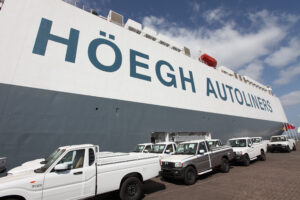The containership, Zim Kingston remains at anchor off the west coast of Canada (as we go to press), having lost more than 100 boxes overboard and suffered a fire. Thankfully, now contained.
Once again, this throws into sharp focus the ongoing issues with modern containerships and particularly those that are carrying an increasing number of boxes.
Big ships equate to big risk and this means a brighter media spotlight should anything go wrong. The largest containerships are likely insured (hull & machinery) for around US$150 million, but their cargo of 20,000-plus boxes will be valued at eight or nine times that amount. So that’s upwards of a US$1 billion in potential losses – a nice round number for the media to latch on to. And, of course, this ignores third party losses and any environmental impact should the worst happen.
A glance at insurance trends for marine claims shows that frequency across all types of claims has continued to decrease, year-on-year, since 2005 – but the frequency of claims related to onboard fires or explosions has remained stubbornly higher. A more granular analysis reveals that the frequency of fires onboard large containerships, particularly those above 50,000GT, has increased every year for the last 15 years and more. Not surprising as the more boxes carried on board, the greater the probability that at least some of them will contain cargo which may self-ignite.
Between 2000 and 2015 there were 56 reported containership fires resulting in around US$1 trillion worth of damage, but in 2019 alone more than 40 onboard fires broke out, including Yantian Express, APL Vancouver and Grande America. Tragically, many resulted in danger for the crew, injuries or even loss of life. In many cases the cause was not known but most experts point their finger at undeclared, mis-declared or poorly stowed dangerous cargoes.
Another worrying trend for ULCCs is an increase in container spills. There appears to be a heightened issue with the integrity and stability of onboard container stacks, particularly in heavy weather. Between 2008 and 2019 an average of 1,382 containers were lost overboard each year. But recently there has been a massive increase. In mid-February of last year, 260 containers were lost from Maersk Eindhoven off northern Japan; two weeks earlier the MSC Aries lost 41 containers in the Pacific. In the same month a further 750 containers were lost by the Maersk Essen and in November last year the loss from the ONE Apus amounted to around 1,800 boxes.
Containerships are no more likely to suffer a collision, grounding or piracy attack than any other class of vessel, but statistically they are more susceptible to an onboard fire. Any vessel on fire will gather media headlines but can we argue that an incident involving a containership is more likely to stir up a media storm?
Like all these things, the answer is, “it depends”.
Of course, the usual variables will come into play: the proximity of the stricken vessel to a coastal population; availability of good images; likelihood of environmental impact etc. But these are relevant to all vessel types. A fire onboard a containership can involve an additional dimension.
In the main, containerships are carrying consumer goods bound for large, sophisticated buying conurbations that won’t be happy to find empty shelves at the local retail park. Many household names will be amongst the hundreds of shippers with cargoes onboard the vessel – potentially a news story to be made from each one. And if supply chains are disrupted, then the wider issues of economic fragility come to the fore – a much more “reader-friendly” case for the journalist to make than it would be for a bulker loaded with iron ore or grain.
We associate ourselves more closely with the goods being carried on a containership and so feel more involved when an incident, or disruption, happens. Consequently, many more “armchair” commentators come out of the woodwork to pronounce judgement and to fan the media flames. And the direct and indirect monetary losses can also be headline-grabbing.
On the whole, it isn’t materially different to manage the media message during a containership incident but we must be aware of the potential for the story to spiral into related directions and to gather momentum rapidly. Local, regional and global media outlets will all have slightly different agendas and each will need careful handling. Sadly, with the statistics showing no let-up in the growing incidence of onboard fires on containerships, solid media management is likely to be required more often.








